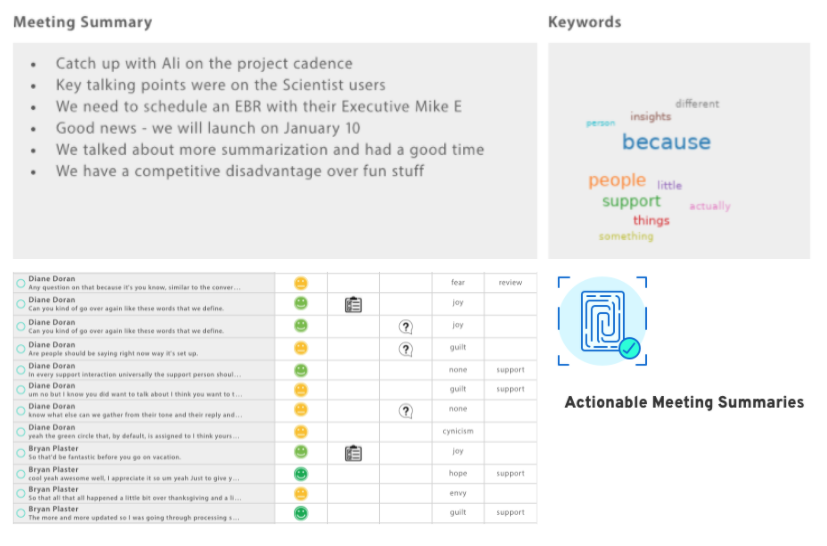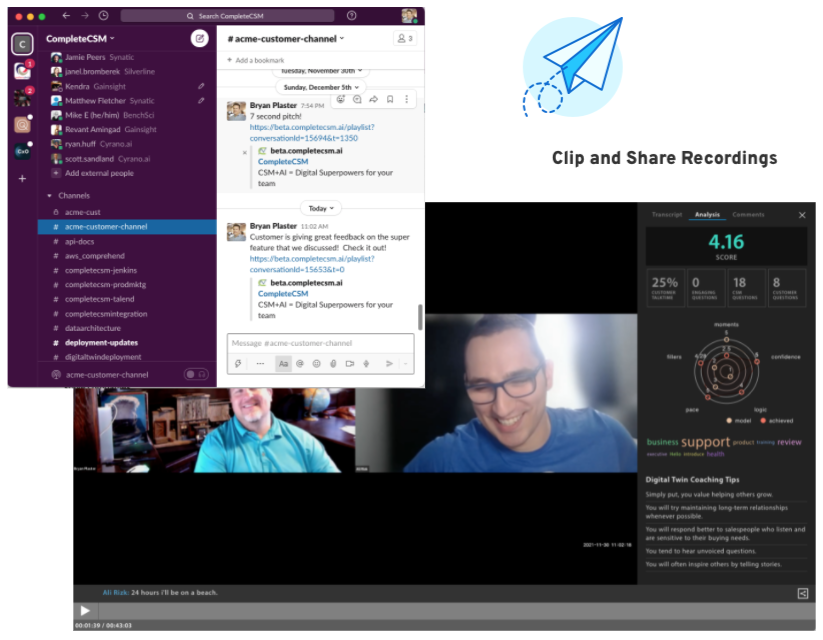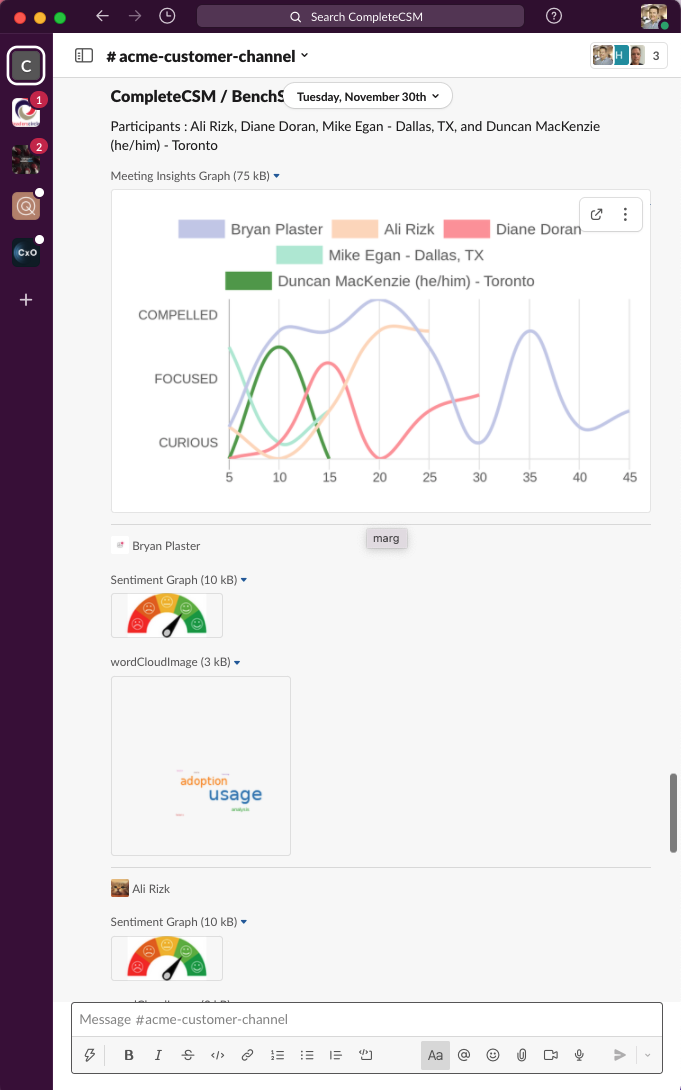There’s more in your meeting recordings than you think!
What’s in a meeting? A lot more than you think. While Zoom and Gong are powerful communication tools, both provide little insight into the meetings they host beyond verbatim transcripts or basic observations. If you want to get more from your meetings, and know exactly what the customer at the other end of the Zoom or Gong was thinking, you’re going to have to dig much much deeper into the data.
More meetings than ever before
Whether due to the pandemic, the latest digital transformation wave or a combination of both, the number of daily customer meetings and interactions has increased exponentially. If you’re a SaaS b2b company, you’ve no doubt got every department talking to the customer multiple times throughout the day. There’s technical support with its hundreds of daily tickets, not to mention the additional web chats, as well as Zoom and Gong calls. Then there’s product marketing and its user research to understand what features customers like best or least. You also have sales probing for more projects or expansion opportunities or teaming up with CSM for planning. And at the center of it all are your CSM managers, driving the customer experience with cadence calls, escalations, and executive business reviews — all while looking for signals of what the customer is going to do next!
If they only knew the insights into customer sentiment and intent they so desperately want are hiding in plain sight within the terabytes of interaction data they and their colleagues are creating.
Is re-watching videos the main reason we record them?
Up to now, the only reason to record a meeting was to rewatch it. When I ask CSMs what they get with Gong or Zoom recording, they almost always reply, “ re-watch my meetings at 1.5X.” Or, “fast forward to the last ten minutes to catch all the action items.” Rarely or never do I hear, “analyzing the data for their sentiment or intent.
Now that these interactions are digital, and the technology has advanced to the point where capturing and analyzing the underlying unstructured data is now scalable and within reach of most budgets, real insight from all this data is finally, really possible.
Setting aside the how, for now, let’s take a quick look at what type of insights and value you can gain from exploring this data.
Automatic meeting summaries
If you’re in a one-on-one customer meeting, taking notes and coming away with the needed action items is relatively easy. You have plenty of time to have a pleasant conversation, ask clarifying questions, and take notes of what happened and what to do next. 
But, what if you’re facilitating a meeting with more than three people? Now it becomes more challenging and difficult to both lead and document the proceeding, opening the door to errors and omissions that could potentially come back to bite you.
With the right technology, the data paired with a powerful analytics engine can serve as your virtual assistant, dutifully creating an automatic meeting summary, with a bulleted smart list of topics, keywords, and, of course, word clouds.
Action items from the meetings.
Every meeting has a point to it, which is usually summed up with a set of takeaways or action items typically re-stated in the last 5-10 minutes of the meet or call. Like with the meeting summaries, accurately recording these callouts to “follow up with product to set up a roadmap meeting with so-and-so,” or “raise with the CTO that you’d like to be a part of the newest beta program, or handle some training tasks for the customer team and, “get it done by December 1st” can be challenging, especially when multiple cross-functional teams are involved.
Typically, these takeaways are recorded by the CSM and entered manually in the CSM or CS system as Call-to-Actions, but what if you could do it automatically, and with 100% accuracy?
Share customer meeting snippets with product or sales teams

Product teams spend weeks, months and often longer building features, and, let’s face it, the last thing they want to hear is that something is broken or doesn’t work the way it should. In many cases, they’ll just ignore the feedback, chalk it up to “user error” or, when pushed, ask for ANOTHER customer meeting because they just can’t BELIEVE that their baby is broken.
Customers are comfortable opening up to their advocates about the product: It’s a circle of trust. Many times you’ll hear exactly how they feel about a feature and a “no holds barred” approach to what they’d like to see in your software or service, so that they can get the most value.
With the right platform, you can actually clip these invaluable insights, enrich them with additional information and context, and share them directly with the product team, effectively eliminating the typical “cycle of denial” from the product improvement process.
What about intent?
Every meeting tells a story. Even a basic transcript provides value, and can tell you not only who said what but also give you some indication of sentiment based on negative or positive word choices, pauses between questions and answers, and etc. Now imagine if you could scale that times, well, infinity, and apply that same scrutiny and analysis to every conversation, call, chat, text, email, and interaction.
That’s essentially how machine learning sentiment models and AI operate with your entire customer interaction dataset. By looking deeper into what’s being said or gestured, the right AI can detect not only how committed each person is to the conversation but also what they intend to do next. This is what is called the Customer Intent score, and it doesn’t stop at that person, but rolls up to the global account and whether each customer intends to churn, expand or renew. But…that is a topic for another day.
We’re just scratching the surface!
Digital transformation is changing how we do business in practically every way, including what we can now do with all those meetings we’re now recording. No longer are they just tools for training or coaching. The data they contain has become too valuable to ignore or leave sitting in a silo.
The three use cases I outlined above are just a small sampling of how that data and AI-generated insights and analytics can support customer success, sales, product, or any part of the enterprise that interacts with customers.
The ability to know what a customer intends to do next is becoming a reality and is too enticing to leave on the table. In my next post, we’ll explore some of the technology and tools businesses are using today to wrangle these insights from their meeting and interaction data.
Learn more at CompleteCSM.AI and we’d love to chat with you!
